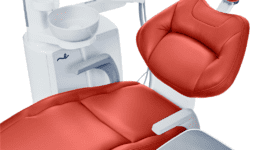TIP ONE: DESIGN – BY KIRSTY HAGUE, INTERIORS AND MARKETING DIRECTOR
A good practice design should lead your private clients on a journey. The style and solution should reflect your brand, the ‘vibe’ you’d like to create, and some of your personality, both on the exterior and interior of the practice. By doing this, you will be creating a memorable and positive experience for your patients and one that gives them confidence to buy into your services. Perhaps think about an amazing restaurant or hotel that you might have been to, where from the moment you arrived outside you were drawn inside, why it held your attention when you were there, and why you, perhaps, dream of going back. Reflecting on a personal experience like this often results in the best designs.
TIP TWO: EQUIPMENT – BY JIM HAGUE, SALES DIRECTOR
When it comes to equipment selection, it is vital to obtain the relevant advice from an experienced and reliable source. In addition, ongoing communication with your chosen provider is key to buying well and achieving a high-end look. There are many questions to ask yourself, including why you are replacing pre-existing equipment or what you are looking to achieve with something new. Consider your likes and dislikes of existing equipment, as it will positively impact your decision (ie resolving old issues, without introducing new ones). Other issues to think about, in partnership with an equipment expert to ensure long-term success without overspending, include:
• Quality/specification/cost of ownership – aesthetics and ergonomics are important, but don’t forget to try it out first, check on expected longevity, parts availability and servicing costs
• Consider the functions you need the equipment to perform. Is the model you are favouring up to the job or could the version below achieve your aims?
• Compatibility – will the replacement equipment work within the existing services/position or will some refurbishment also be needed, perhaps incurring extra costs?
TIP THREE: PROJECTS AND EXPANSION – BY JAMES FLETCHER, HEAD OF PROJECT MANAGEMENT
Whether a principal is looking to complete a new build, refurbishment or extension, a key consideration is continuity and flow through the practice, from the patient walking through the door into reception to when they sit in the dental chair. This is often easier to achieve with new start squat installations because you have a blank canvas, while refurbishment and/or expansion may represent a greater challenge. That mentioned, there are always ways to work around such challenges. For example, if you are looking to complete a surgery refurbishment only, consider the reception/communal spaces as well, even if only for a freshen up. This way the patient journey is not disjointed when it comes to the feel of the practice. Budget is, of course, a key aspect of any practice project, so it is extremely important to engage with a specialist and knowledgeable supplier early on, who can help you develop your wish list, prioritise it, and offer practical advice as to what is achievable.
TIP FOUR: DIGITAL – BY ARTUR SILVA, HEAD OF DIGITAL
The need to embrace digital technology is increasing, to keep up with technological advancements and competitors, and, above all, provide the best possible care for patients. Most practices would benefit tremendously from being able to provide in-house diagnostic and treatment tools such as CBCT, intraoral scanning and CAD/CAM capability. However, this might seem far off on the horizon if, for instance, you’ve only started toying with the idea of transitioning into a more digital workflow. A great way to dip your toe in the digital water comes in the form of phosphor plate scanners and intraoral cameras. Both provide opportunities to improve workflow and record keeping. They can also help to educate patients with high resolution X-rays and intraoral photos, which are great for ‘before and after’ treatment shots. Some cameras can even reliably identify caries, inflammation and healthy tissue. With a steady start and a trustworthy supplier by your side offering ongoing support, it will soon become easier to grasp the possibilities a fully digital workflow offers.
TIP FIVE: ENGINEERING SUPPORT – BY ESTELLE CLARKE, SERVICE AND AFTERSALES MANAGER
Having an engineering and service team on hand that knows your practice and its history will reduce downtime and enable attendance with the parts needed to fix problems without delay. Early morning appointments mean your needs can be attended to before the practice opens, giving you the opportunity to keep patients’ appointments on track and limit disruption at the practice. Meanwhile, annual servicing keeps your equipment in the best health, too. It certainly reduces breakdowns and adds to the longevity and smooth running of your equipment. Let’s not forget that it will also keep you in line with CQC requirements. In a nutshell, a highly customer focused team providing a comprehensive set of services will enable you to build, run and maintain your perfect practice.














